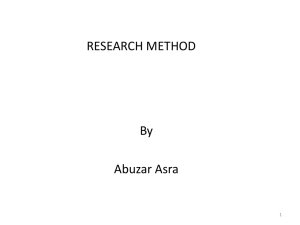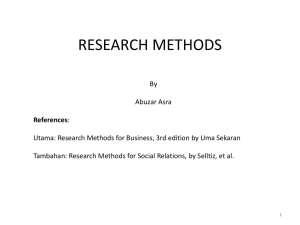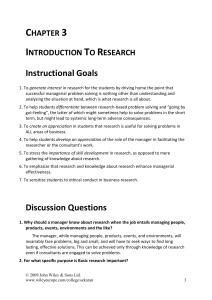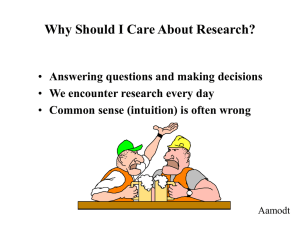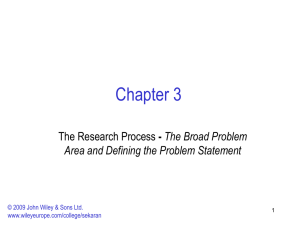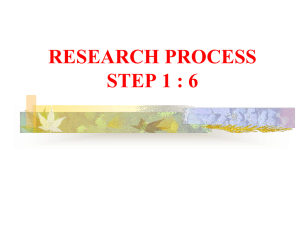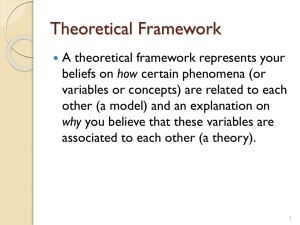ch2-saks
advertisement
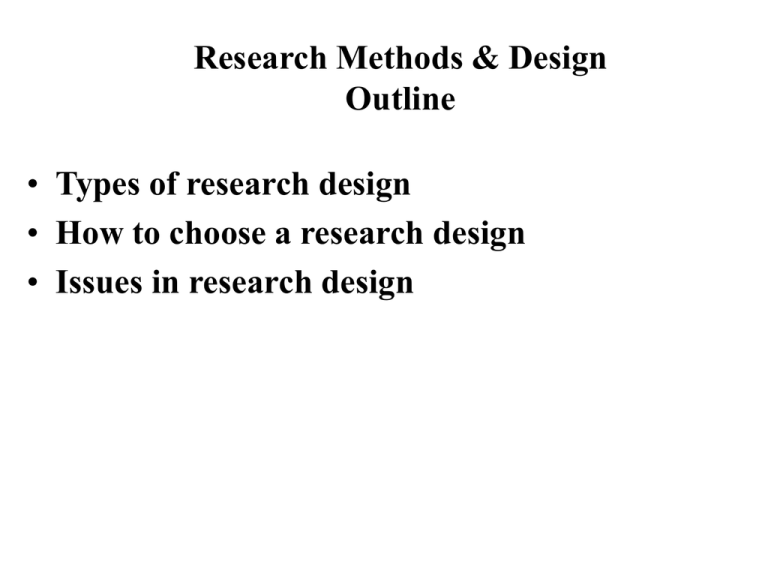
Research Methods & Design Outline • Types of research design • How to choose a research design • Issues in research design Types of Research Design • • • • • Correlational Field (survey) Experimental Qualitative Meta-analysis Sekaran, Saks Types of Research Design • Correlational Study • Explores or tests relations between variables • “Rules out” alternative variables that could play a role in relations between variables • Field • Studies participants in their natural setting • Maximizes realism Sekaran, Saks Types of Research Design • Experimental • Directly establishes cause-effect nature of relationship between variables • Decreases ambiguity • Laboratory vs. Field Experiment (Sekaran p. 130-131) • Realism vs. internal control issues Copyright © 2003 John Wiley & Sons, Inc. Sekaran/RESEARCH 4E 7A Copyright © 2003 John Wiley & Sons, Inc. Sekaran/RESEARCH 4E 7B Types of Research Design • Qualitative • Non-quantitative • Not necessarily informal data collection (cf. Saks) • Examples • Interview/focus group transcripts • Some kinds of observational/archival data • Critical incidents methodology • Helps in • Formulating hypotheses • Deeper/richer understanding of phenomena • Interpret organization-specific results Types of Research Design • Meta Analysis • Statistically combines results of existing research to estimate overall size of relation between variables • Helps in • Developing theory • Identifying research needs, • Establishing validity/effectiveness of HR tools • Can replace large-scale research studies • Better than literature reviews Aamodt Exercise 1-1 • Identify the type of research design for each study description Guns & Crime Article • What are the two hypotheses re: the relation between gun ownership and crime? • What are different ways to measure gun ownership? • Identify the experimental and correlational methods used to test the hypotheses Research Methods & Design Outline • Types of research design • How to choose a research design • Issues in research design How to Choose a Research Design • • • • Does it adequately test the hypothesis? Does it identify & control extraneous factors? Are results generalizable? Can the hypothesis be rejected or retained via statistical means? • Is the design efficient in using available resources? How to Choose a Research Design • Does it adequately test the hypotheses? • Hypothesis determines participants, variables measured & data analysis methods • Hypotheses tested in student projects • Requirements of proposal How to Choose a Research Design • Does it identify and control extraneous factors? • Eliminate alternative explanations for results • Control depends on design • Correlational= variables are measured and effects are statistically controlled • Experimental= variables are assumed to randomly vary across participants and groups because of random selection & assignment Copyright © 2003 John Wiley & Sons, Inc. Sekaran/RESEARCH 4E 7C Copyright © 2003 John Wiley & Sons, Inc. Sekaran/RESEARCH 4E 7D How to Choose a Research Design • Are results generalizable? • Replicate to other samples and other contexts • Issues with laboratory vs. field experiments – See slide 18 • Issues with correlational data collected in laboratory vs. field – Artificiality of setting – Nature of samples used Copyright © 2003 John Wiley & Sons, Inc. Sekaran/RESEARCH 4E 7E How to Choose a Research Design • Can the hypothesis be rejected or retained via statistical means? (statistical conclusion validity) • Need reliable measures • Need large enough sample to detect true effect & avoid Type 1 & 2 errors • What is a null hypothesis? • What is an alternative hypothesis? Types of Decisions based on Statistics Reality Effect does Effect not exist Exists Effect does not Exist Correct Decision Type 2 Error Conclusion Effect Exists Type 1 Error Correct Decision How to Choose a Research Design • Is the design efficient in using available resources? • Optimal balance between research design, time, resources and researcher expertise Research Methods & Design Outline • Types of research design • How to choose a research design • Issues in research design Issues in Research Design • Research context • Nature & size of sample • Data sources Issues in Research Design • Research Context • One or several organizational contexts • Laboratory vs. field setting– depends on • Goal of establishing nature of phenomenon (or process) that exists in most contexts • Generalizability of results • Control required of extraneous/nuisance variables Issues in Research Design • Nature of sample • Random vs. stratified • Convenience sample • Student vs. field based sample • Size of sample determines • Generalizability of results • Ability to detect a true effect Issues in Research Design • Data Sources: Self report • Common method variance • Similar response format • Consistency bias of participants • Unreliability of measures • Social desirability • Alternative methods to questionnaire (e.g., interviews, behavioral, archival) • Multiple times of data collection • Alternative sources (e.g., supervisor, peer) • Measure of individual’s susceptibility to social desirability Issues in Research Design • Data Sources: Self report • Response shift bias • Alpha =real (condition) change • Beta = change in frame of reference (change in standards) • Cross cultural difference in uses of ends vs. middle of response scale • Gamma=change in meaning of construct/variable • Cross cultural differences in meaning of term Issues in Research Design • Data Sources: Alternatives • • • • • Coworkers (e.g., subordinates, supervisors, peers) Archival Biological Trace Objective Research Methods & Design RECAP • Types of research design • How to choose a research design • Issues in research design
